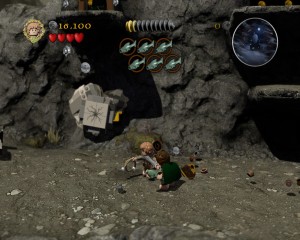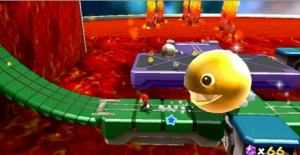Thanks to a recent sale, I decided to pick up Lego Batman 2 and Lego Lord of the Rings. The whole “Legoing” of brands was a craze that I never really took to, even after being there when the very first Lego game came out. After spending time playing them both, I found myself still confused as to why they’re so popular design wise.
As I thought about it more, I started thinking about the challenges of appealing to multiple audiences and why Nintendo has done it right in the past and where Traveler’s Tales messes up.
E for Everyone:
Before I get started I need to preface this post with the following. For those that have read past posts where I talked about Nintendo, then you know that I’ve complained about them not appealing to older audiences with many of their flagship titles. But when Nintendo does buck their general trend, their game design is much stronger than other games that are being aimed for both kids and adults.
Creating a game that is meant for both kids and adults is incredibly difficult as you are dealing with two very different groups. The first one being people who don’t have the experience or skill level while the latter are masters at it. This presents a careful balance of creating levels and situations that don’t completely overwhelm new players, while not being boring or unfulfilling for expert players.
And this is very hard to get right and is similar difficulty wise to designing a game for both action and RPG fans to enjoy. When it comes to design, there are two popular methods to get this cross group appeal working.
First is designing from the bottom-up in a manner of speaking: Making something for new players first and gradually raising the skill level as you go. Here, you are putting the new players first and asking the expert players to essentially go through “busy work” until both groups are on equal footing.
The other method is going from top-down: Making a hard or more complex experience and putting in additional systems or mechanics designed solely for new or inexperienced gamers. These could be hints, level skips or anything that prevents or mitigates someone getting stuck or frustrated.

Advanced content is not about becoming skilled at the game, but simply doing the same things over again but with a different character.
As you can see, the problem with both schools is that one group gets the short end of the stick at the start.
I’ve said it before, but telling someone that” the real game begins at X” is not good game design and forcing players to just waste time on stuff beneath them is boring.
Even with the hint systems, throwing new players into the deep end can make them feel frustrated and if the game is too hard, they may not stick around to learn it.
A great game designer can find a way to merge these two opposing schools and find a way to balance the game for both new and old gamers. And despite making fun of them sometimes, Nintendo is still one of the best development houses around for this kind of compromise.
Variable Level Design:
Some of the best games from Nintendo in my opinion have been able to walk that line between casual and hardcore appeal. Accomplishing this requires a very careful eye to detail when it comes to level design and mechanics.
In the Mario Galaxy series, the levels were designed with an escalating scale of difficulty and complexity. Meaning that a new player was being tested with each new world to explore with the final levels offering more challenges compared to the earlier ones. However, every level from start to finish was designed with shortcuts and optional challenges that an expert player could go through from the very beginning.

Nintendo doesn’t do it often, but when they create harder or hardcore experiences, they really do go all out.
This meant that the path through a level was different based on the person’s skill level.
Someone brand new wasn’t going to go after optional stars or hidden coin challenges and that was okay as they weren’t meant for new players. While expert players were awarded from the start and could make progress a lot quicker without being held back.
And advanced moves like wall jumping or somersault jumps were considered optional at the beginning of the game. And as the levels got more challenging, these advanced maneuvers would be slowly introduced to new players so that they would hopefully get to the same point skill wise as expert players.
Nintendo has a penchant for adding difficulty to optional challenges and when they want to make something hard, by God they’re going to make something hard. The special worlds of Super Mario Galaxy 1 and 2 were incredibly challenging even for someone like me and it took some practice to get through.
And there are other examples that I go into like the Kirby games and Kid Icarus that also had optional challenges for expert players while delivering a very easy normal experience.
Going back to Traveler’s Tales with the Lego games, the difference is almost night and day.
Lego No:
Playing through both Lego Batman and Lego Lord of the Rings, the focus on kid audiences was immediately apparent in the level design. There really wasn’t any challenge to the levels but just busy work repeating the same mechanics in similar situations. Two levels early on literally made use of the same mechanic and puzzles in almost mirrored circumstances. Any time the player does something, the game stops and shows a cut scene to tell them that they need to do something else now.
In Lego Batman, every time you picked up a new suit to get a power, you have to watch the same three second cut scene telling you the name of the suit in every level. Not only was it maddening but it upset the flow of the game to stop and start for no reason.
Optional content isn’t challenging or involving but just “stuff” that’s there to check off a list. Many levels feature optional items and rewards to find that are locked because you don’t have the prerequisite character until you can come back to play in free play mode.
That is one of my biggest pet peeves with design: Telling me that despite my skill, I have to repeat the same thing exactly again but with an arbitrary character or condition to get everything. And it’s not even changing how I play but coming back with “the right key” to open the door.

The brilliant element of Nintendo’s game design is that multiple skill levels can experience their levels differently without being bored or overwhelmed.
Playing through the levels, there were no shortcuts or areas for expert players. Instead everyone took the same basic path from beginning to end.
Watching the same cut-scenes and repeating the same puzzles. Collecting silver legos, finding all those studs and doing those side quests just gave me stuff that didn’t feel all that rewarding.
When I play a game like Mario Galaxy, I felt like Nintendo was trying to teach you how to play and improve your skills. With the Lego games, they feel more like a way to see how many repetitive tasks someone can fit into one game to stretch it out.
And lastly there were just poor quality issues: Camera not working right, characters not aiming or behaving right, getting stuck on objects and more. I remembered that Traveler’s Tales also worked on a Crash Bandicoot game that I despised due to poor mechanics and bugs so at least the tradition continues.
While it may be easy to scoff at Nintendo and lump their games together with stuff like the Lego games, it’s important to look critically at their game and level design. Just because Nintendo games start off very easy for new players doesn’t mean that they end that way. And while the main path may not be that challenging, Nintendo saves the hard stuff for people willing to go off the beaten path.


